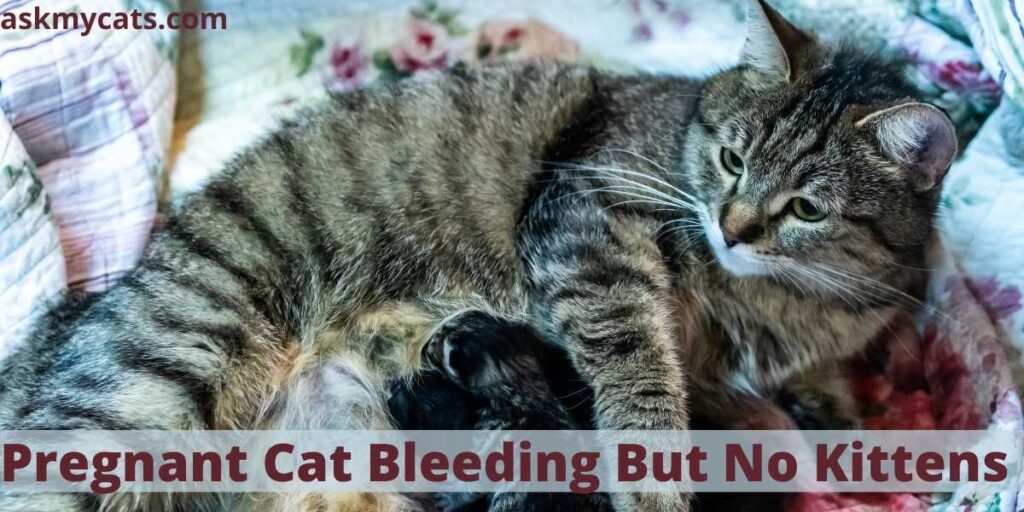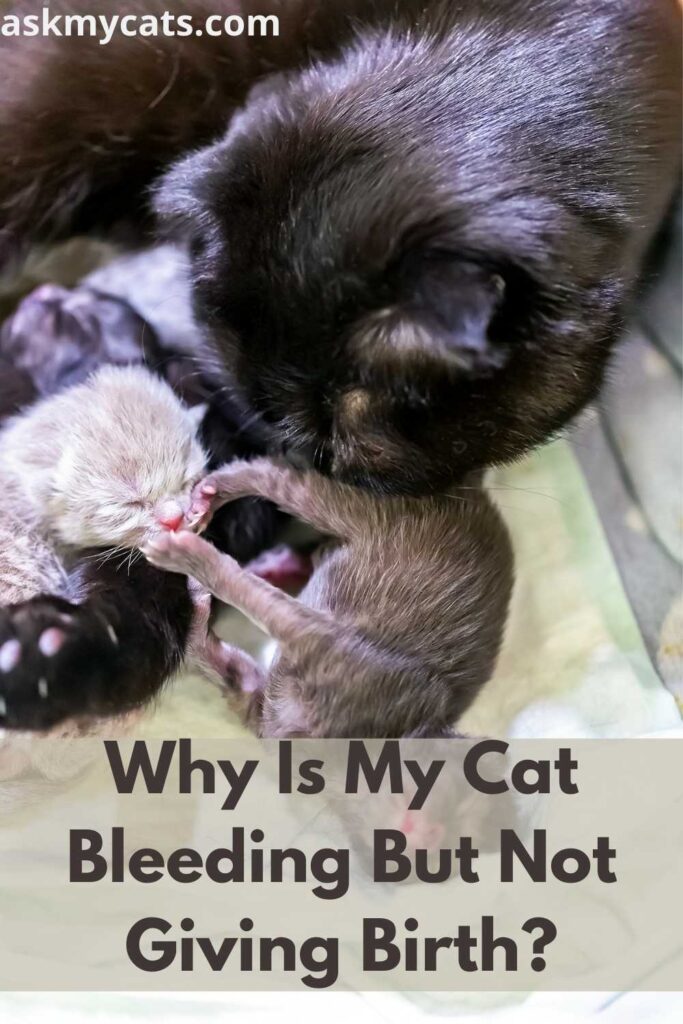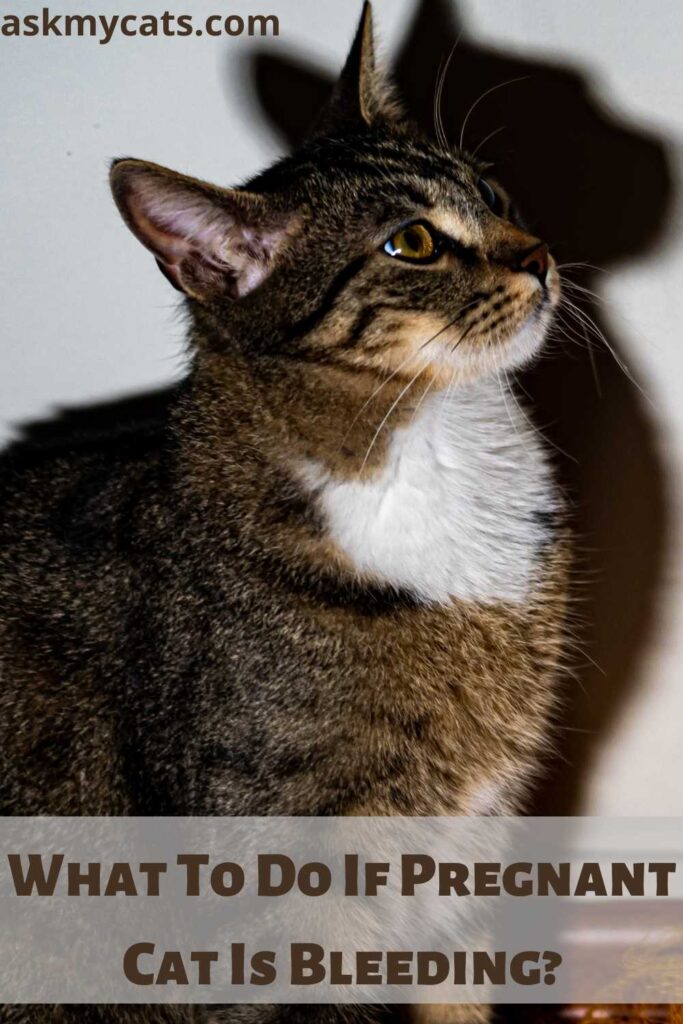From quick breathing to particularly twitchy and restless behavior, you’ll know if your beloved queen cat is on the verge of giving birth. Keep an eye out for any signs that your pet will be getting some fluffy new additions to her life shortly.
Complications are uncommon in cat pregnancies, although they do occur.
So, why what is exactly happening when a pregnant cat bleeds but there is no kittens insight?
In expectant cats, vaginal bleeding or spotting is not a usual indicator of labor. If you find that your cat is bleeding in any way, please contact your veterinarian right once. It’s possible that the bleeding is due to an emergency medical problem, such as a spontaneous abortion, so don’t waste any time.
Keep reading the article to know about why your pregnant cat is bleeding.


Give Your Cat the Perfect Day
Get the Free Ebook!
Do Cats Bleed Before Having Kittens?
No, normally cats don’t bleed before having kittens.
Vaginal bleeding during a feline pregnancy is unusual and should be taken seriously.
If the bleeding occurs in the early or middle stages of pregnancy, the queen is most likely to have suffered a miscarriage or aborted the infants.
If the bleeding occurs at the end of the pregnancy, the mother may be about to give birth prematurely, necessitating rapid veterinary assistance.
Why Is My Cat Bleeding But Not Giving Birth?
There could be two reasons behind your cat bleeding but not giving birth; 1. Miscarriage and 2. Giving birth prematurely.

1. Miscarriage
The queen is most likely to have had a miscarriage or aborted the infants if the bleeding happens in the early or middle stages of pregnancy.
Miscarriage in cats occurs when your cat’s pregnancy is terminated either intentionally or unintentionally.
Under the guidance and/or advice of your veterinarian, a chemically induced miscarriage may be performed.
It can also be caused by a number of hormonal or physical factors.
You may not notice any signs or symptoms if your cat is pregnant early on, and the fetuses may be reabsorbed by your cat’s body.
Your cat may miscarry later on and develop maternal instincts and behaviors, such as producing milk and crying or pacing in search of offspring. If you suspect your cat is miscarrying, contact your veterinarian right away.
If the pregnancy is in its early stages, the signs of miscarriage in your cat may be modest. In most cases, however, you’ll discover indicators of a miscarriage.
These may include the following:
- Bloody discharge
- The disappearance of fetuses previously seen in ultrasound or felt via palpation
- Abdominal straining
- Discomfort
- Depression
- Dehydration
- Fever
- Delivery of premature, dead, or nonviable fetuses
Miscarriage is a condition that can be caused by a number of factors. While this may not always be possible, it is crucial to try to determine the underlying reason for the miscarriage in order to rule out infections or other illnesses that could put your cat’s life at risk.
Among the most common causes are:
- Feline leukemia virus
- Feline herpesvirus
- Bacterial diseases such as chlamydia
- Protozoal infections
- Injury
- Exposure to chemicals known to induce labor or miscarriage
- Congenital defects
- Inbreeding results in genetic issues
- Nutritional deficiencies
- Severe stress
- Hormonal imbalance
A comprehensive physical exam will be used to diagnose a miscarriage in your cat. If your cat has miscarried at home, if feasible, bring any aborted fetuses to your veterinarian for an examination.
The fetuses may reveal significant information about the cause of the miscarriage. During the initial appointment, your veterinarian may order ultrasound or x-ray imaging to ensure that no extra pregnancies have been kept.
Living fetuses may need to be supported to avoid miscarriage, and dead fetuses may need to be removed from the cat to avoid infection and possible death.
These photos will also allow you to examine your cat’s interior organs.
You should offer a detailed history of your cat’s pregnancy during the initial examination. The approximate date of conception and the identity of the sire, if known, may be crucial information for a correct diagnosis.
The onset of symptoms and duration of any unusual behavior, such as a lack of appetite or your cat starting to nest, will also be useful.
A thorough blood panel will also be ordered by your veterinarian. This will enable your veterinarian to detect any infection and offer an examination of different hormone levels throughout your cat’s body.
If the cat has symptoms of a cold or infection, you should get smears from the nose, ears, and mouth to see if your cat has an upper respiratory infection or anything else. In order to test for parasites, a stool sample may be requested.
You might also like to read about Cat Bleeding After Giving Birth? Is It Normal?
2. Giving Birth Prematurely
If the bleeding happens at the conclusion of the pregnancy, the mother may be on the verge of giving birth prematurely, demanding immediate veterinary help.
While a kitten born on or after the 61st day of pregnancy has a good chance of surviving, contractions and labor before that can put the cat and its mother in danger.
Premature contractions and labor are common in cats during pregnancy, although they can occur at any time.
A cat would give birth after 63 days of pregnancy in a perfect environment. However, a pregnant cat may go into labor too soon due to a variety of circumstances ranging from stress to bacterial illnesses.
There are a few telltale signals when a cat is about to go into labor. If these symptoms appear before the 61st day of pregnancy, the cat is likely to go into premature labor:
- Bloody vaginal discharge
- Lack of appetite
- Loud and frequent vocalizing
- Hiding
- Unexplained affection
Early labor in cats can be caused by a variety of factors, but they can be divided into two categories: stress-related and medical.
Medical
- Bacterial or viral infections
- Genetic disorders
- Ovarian cysts
- Malnutrition
- Death of a fetus
- Hormonal imbalances, specifically a sudden drop in progesterone
- Lyme disease
Stress-Related
- Loud noises
- Emotional disturbances like screaming or fighting owners
- Excessively cold temperatures
- A recent move
- Receiving vaccinations while pregnant
If a cat begins to show signs of early contractions, it should be sent to a veterinarian as soon as possible.
A detailed medical history of the cat, as well as some information about the pregnancy, will be required by the veterinarian.
This contains information about the cat’s general health prior to and during the pregnancy, as well as details about the symptoms presented and any stressful events that may have contributed to premature delivery.
The veterinarian will conduct a physical examination of the cat after they have this information, taking care not to upset the cat further.
The veterinarian may need to do one or more of the following tests, depending on the results of the physical examination: a blood chemical profile, an electrolyte panel, or a urinalysis.
A blood test will disclose any problems with progesterone levels, while a urinalysis will identify any abnormalities or diseases that could be causing the early labor.
Following these tests, the veterinarian will perform an ultrasound to determine whether fetal mortality or improper positioning of the fetus is to blame for the early labor.
If the kittens are stillborn or die soon after birth, the veterinarian may need to perform a necropsy to determine the cause of death.
This will help establish whether the problem will impact the cat later in life and whether future pregnancies will be viable.
Interesting Read: Why Is My Pregnant Cat Leaking Fluid?
What To Do If Pregnant Cat Is Bleeding?
After you find out that your pregnant cat is bleeding take her to the vet immediately for further assistance.

The vet will perform the above-mentions diagnostic on your cat and begin her treatment. The treatment will differ depending on what your cat is suffering from.
Bleeding in pregnant cats usually is a sign of miscarriage or premature birth.
Here are the treatments for them both: –
1. Miscarriage
Your cat’s post-miscarriage care will be determined by whether she requires stabilization and the underlying reason for the miscarriage.
If there are any retained fetuses, your veterinarian may give your cat medicines that trigger contractions to help clear the residual tissue.
This procedure will take place at your veterinarian’s clinic and will keep your cat from becoming infected as the fetuses break down inside the uterus.
In the event of an illness, your veterinarian may give a broad-spectrum antibiotic while the precise bacterium causing the infection is identified.
If the cold is slight, physicians may offer rest and drinks as a treatment. When it comes to parasites, your veterinarian will prescribe the necessary parasite treatment. Orally, these are usually given in the form of a paste, gel, or tablet.
If your cat’s injury is the root cause, your veterinarian may prescribe pain relievers or anti-inflammatory medications to help him recover faster.
Finally, your veterinarian may advise spaying or neutering your cat to avoid future pregnancies.
This is especially true if the miscarriage was caused by congenital flaws, hormonal abnormalities that are difficult to treat in future pregnancies, or if the miscarriage was the result of many miscarriages.
In most circumstances, your cat will recover well following a miscarriage as long as the underlying illness is treated properly.
It will be critical to administer all prescription medications in the correct doses, especially if an infection is present.
If your cat appears unhappy or lethargic, or pacing and being aggressive, you may need to seek extra help.
In these instances, isolating your cat in a quiet, warm, and comfortable environment until the hormones generated by the loss and childbirth diminish may be appropriate.
Overall, your cat’s chances of recovering from a miscarriage are good, and she should live a long and healthy life.
2. Premature Birth
The cat will very certainly need medical attention at this point, either for the underlying condition causing the problem or for the stillborn kittens.
Stillborn Kittens: Stillborn kittens will almost always require surgical removal. The surgery is relatively low-risk for the cat, but it could be risky for other unaffected fetuses still in the womb.
Other Treatments: Unfortunately, once early labor has begun, there is nothing that can be done to halt it.
The veterinarian will most likely treat the cat and any surviving kittens for any difficulties, but he or she may not be able to stop the early labor.
Following the delivery, the cat should be kept secluded from other animals for three weeks, with exceptions made for any surviving kittens, of course.
Even pets who live in the house and are familiar with the cat should be kept at a safe distance, as the cat will need time to recover from labor. The cat should be maintained in a warm, quiet environment by itself as much as possible.
It is critical to bring a cat in for a checkup after three weeks if it has gone through early labor.
The cat should be back to normal at this point, and if the cat is still weak or unwell after three weeks, it could be a symptom of additional ailments.
It’s crucial not to give a cat any medication unless it’s been approved by a veterinarian while it’s nursing its kittens. Many drugs can damage kittens by affecting the cat’s milk supply.
Frequently Asked Questions
Are miscarriages common in cats?
Cats are known to have spontaneous abortions on a regular basis (miscarriages). This reaction can be caused by a variety of medical conditions. After a miscarriage, the cat should be checked right away to rule out any more significant underlying health issues.
How to keep pregnant cats on safe flea preventatives?
It’s even more crucial to maintain your cat on a safe, vet-approved flea preventive during pregnancy. Always check with your veterinarian to see if a particular flea preventive is suitable for pregnant cats. It’s important to keep your cat flea-free not just for their own well-being, but also for the safety of their kittens. One of the most common causes of death in young kittens is flea anemia.
How to make a cat comfortable for giving birth?
Pregnant cats are quite self-reliant, and they will normally choose their own peaceful spot to nest before giving birth. While your cat may choose where to give birth on her own, it’s a good idea to set up a nesting box or area in a peaceful section of the house. You can use a large cardboard box with low sides to allow your cat to easily step in and out, or simply place soft, clean bedding on the floor. For bedding, you can use newspaper or towels. Place her litter box, food, and water in close proximity to her nursing babies so she may quickly access them.
